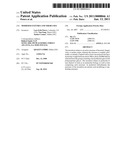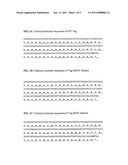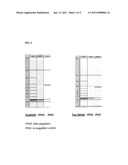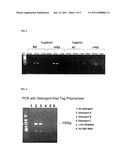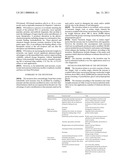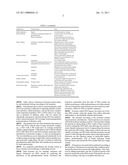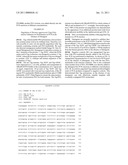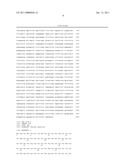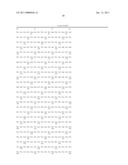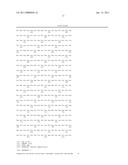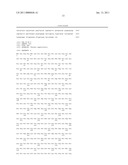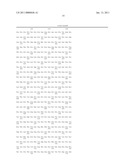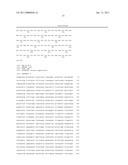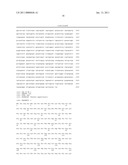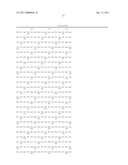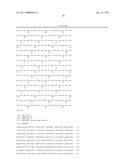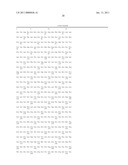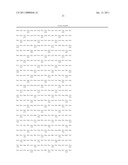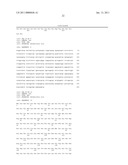Patent application title: MODIFIED ENZYMES AND THEIR USES
Inventors:
Lars-Erik Peters (Lafayette, CO, US)
Nan Fang (Neuss, DE)
Janina Cramer (Hilden, DE)
Assignees:
Qiagen GMBH
IPC8 Class: AC12P1934FI
USPC Class:
435 912
Class name: Nucleotide polynucleotide (e.g., nucleic acid, oligonucleotide, etc.) acellular exponential or geometric amplification (e.g., pcr, etc.)
Publication date: 2011-01-13
Patent application number: 20110008846
Claims:
1. A composition comprising an enzyme covalently coupled with at least one
polymer having a molecular weight between about 500 to about 50,000
daltons, wherein the at least one polymer is polyethylene glycol or
polypropylene glycol, wherein the enzyme has a nucleic acid modifying or
replicating activity, wherein the at least one polymer is bound either to
an amino acid that is present in the amino acid sequence of the enzyme in
its natural state or to an amino acid that has been incorporated into the
enzyme either in addition to an existing amino acid or at the position of
an existing amino acid, and wherein the enzyme is of bacterial, fungal,
viral, or archae origin.
2. The composition of claim 1, wherein the polymer has a molecular weight of between about 750 and 20,000 daltons.
3. The composition of claim 1, wherein the enzyme carries between 1 and 100 polymer moieties per enzyme molecule.
4. The composition of claim 1, wherein at least one polymer is polyethylene glycol.
5. The composition of claim 1, wherein at least one polymer has at least one functional endgroup, or one homobifunctional endgroup or one heterobifunctional endgroup.
6. The composition of claim 5, wherein at least one polymer has at least one heterobifunctional endgroup selected from the group of maleimide, vinyl sulphones, pyridyl disulphide, amine, carboxylic acids or NHS esters.
7. The composition of claim 6, wherein at least one endgroup is maleimide.
8. The composition of claim 1, wherein polymer is bound to at least one reactive amino acid comprising lysine, cysteine, histidine, arginine, aspartic acid, glutamic acid, serine, threonine or tyrosine.
9. The composition of claim 1, wherein at least one polymer is bound to a reactive amino acid located close to the N-terminal end of the enzyme or close to the C-terminal end of the enzyme.
10. The composition of claim 1, wherein the polymer is bound to the N-terminal amino group of the enzyme and/or the C-terminal carboxylic acid of the enzyme.
11. The composition of claim 1, wherein the enzyme is a polymerase, ligase, endonuclease, exonuclease, methyltransferase, recombinase, polynucleotide kinase, phosphatase or sulfurylase.
12. The composition of claim 11, wherein the polymerase is a DNA-dependent DNA polymerase, an RNA-dependent DNA polymerase, or an RNA-dependent RNA polymerase.
13. The composition of claim 12, wherein the polymerase is from a thermophilic organism.
14. The composition of claim 13, wherein the polymerase is from the genii of Thermus, Aquifex, Thermotoga, Thermocridis, Hydrogenobacter, Thermosynchecoccus or Thermoanaerobacter.
15. The composition of claim 14, wherein the polymerase is from Aquifex aeolicus, Aquifex pyogenes, Thermus thermophilus, Thermus aquaticus, Thermotoga neapolitana, Thermus pacificus or Thermotoga maritima.
16. The composition of claim 12, wherein the enzyme is a Pol-A-type polymerase.
17. The composition of claim 16, wherein the at least one polymer is coupled to lysine, cysteine, or both lysine and cysteine.
18. The composition of claim 12, wherein the amino acid is surface exposed.
19. The composition of claim 16, wherein the at least one polymer is coupled to one or more cysteine and/or lysine residues that have been incorporated into a Pol-A-type polymerase at a position corresponding to the position of the following amino acids of Taq polymerase Leu461, Ala521, Gly648, Ala653, Ser679, Ala683, Ser699, Ser739 Ala814, Ser829 and Glu832.
20. A method of modifying or amplifying a nucleic acid, wherein the nucleic acid to be modified is present in a reaction mixture comprising a polymerase covalently coupled with at least one polymer having a molecular weight between about 500 to about 50,000 daltons wherein at least one polymer is polyethylene glycol or polypropylene glycol or both, wherein the polymerase has at least a nucleic acid modifying and/or replicating activity, wherein at least one polymer is bound either to an amino acid that is present in the amino acid sequence of the polymerase in its natural state or to an amino acid that has been incorporated into the polymerase either in addition to an existing amino acid or at the position of an existing amino acid, and wherein the polymerase is a DNA-dependent DNA polymerase, an RNA-dependent DNA polymerase, or an RNA-dependent RNA polymerase.
21. The method of claim 20, wherein the reaction is an amplification reaction.
22. A method of pegylating a nucleic acid modifying enzyme, wherein the enzyme is altered by the introduction of an amino acid or by the alteration of an amino acid, to which polyethylene glycol or polypropylene glycol may bind covalently.
23. A kit comprising a composition comprising an enzyme covalently coupled with at least one polymer having a molecular weight between about 500 to about 50,000 daltons wherein at least one polymer is polyethylene glycol or polypropylene glycol or both, wherein the enzyme has at least a nucleic acid modifying and/or replicating activity, wherein at least one polymer is bound either to an amino acid that is present in the amino acid sequence of the enzyme in its natural state or to an amino acid that has been incorporated into the enzyme either in addition to an existing amino acid or at the position of an existing amino acid, and wherein the enzyme is of bacterial, fungal, viral, or archae origin.
Description:
FIELD OF THE INVENTION
[0001]The invention is in the field of molecular biology, diagnostics, and in in-vitro assays. In particular the invention is in the field of enzyme chemistry, more in particular the field of storage and activity of enzymes in particular DNA modifying and amplification enzymes.
BACKGROUND OF THE INVENTION
[0002]Enzymes are proteins that catalyze chemical reactions. Almost all processes in a biological cell need enzymes in order to occur at significant rates. Like all catalysts, enzymes work by lowering the activation energy for a reaction, thus dramatically accelerating the rate of the reaction. As with all catalysts, enzymes are not consumed by the reactions they catalyze, nor do they alter the equilibrium of these reactions. However, enzymes do differ from most other catalysts by being much more specific. Enzymes are known to catalyze about 4,000 biochemical reactions.
[0003]Enzyme activity can be affected by other molecules. Inhibitors are molecules that decrease enzyme activity; activators are molecules that increase activity. Many drugs and poisons are enzyme inhibitors. Activity is also affected by temperature, chemical environment (e.g. pH), and the concentration of substrate. Many enzymes are used commercially, for example, in the synthesis of antibiotics. In addition, some household products use enzymes to speed up biochemical reactions (e.g., enzymes in biological washing powders break down protein or fat stains on clothes; enzymes in meat tenderizers break down proteins, making the meat easier to chew).
[0004]The stability of peptide bonds ensures that the primary structure of proteins remain intact under biological conditions. Of course, proteases in the environment can cleave the bonds and break a protein apart. Long term chemical changes to proteins include deamidation of asparagine (alkaline pH and phosphates in buffers promote this), oxidation of thiol- or aromatic ring-containing amino acids (usually by heavy metal ions), beta elimination, etc.
[0005]The tertiary structures of proteins which largely determine the protein's function are vulnerable to changes in their environment. The chances of adversely affecting proteins increase as they are manipulated more (purification, freezing, thawing). Proteins at 4° C. usually have shelf-lives of only months.
[0006]The first hint that a protein has stability problems is the appearance of precipitates in the protein solution. Such precipitation can occur over long term even if precautions have been taken to avoid acute stresses (like freezing and thawing).
[0007]One can wear gloves and use clean tubes and pipette tips, protect protein solutions from contamination with proteases and chemicals in the environment.
[0008]Proteins need to be stored at a high level of concentration--at least 1 mg/ml. This may not be realistic in some cases and so, if possible, an inert protein such as BSA should be added to raise the total protein concentration to 10-15 mg/ml. The draw back of course is that BSA may interfere with some reactions and applications.
[0009]Protein solutions should not be vigorously shaken by vortexing. That not only generates bubbles and raises oxygen levels in the solution, but can also affect protein structure because of the high shearing forces. Many proteins so far require detergents for storage. Shaking such a solution will result in bubble production.
[0010]The range of temperatures that a protein goes through during freezing and thawing exposes it to extremes of pH and salt. To lower this degrading effect during freezing, protein solutions should be snap frozen by immersing tubes in dry ice and ethanol/acetone mixture.
[0011]One needs to be careful about the buffer used to store a protein in. For enzymes, storage buffers ideally are the same ones in which the enzyme shows good activity. Similarly for pH although it may need to be different if the optimal pH is unsuitable for downstream applications like chromatography. Phosphates in some buffers can inhibit certain enzymes. Some proteins require certain ions like magnesium and/or certain concentration of NaCl for optimal stability. At the same time even 150 mM NaCl can promote aggregation of certain proteins. Reducing environment, because of low pH and reducing agents is usually detrimental to proteins that have disulfide bonds (usually lumenal and extracellular proteins). However, they are usually needed (1-5 mM) for proteins that have free thiol groups, usually intracellular proteins. Some proteins can also be more stable when their ligands are present in the solution. E.g., galectin proteins retain functionality when stored with lactose.
[0012]Heavy metal ions can be damaging to many proteins, primarily by oxidizing thiol groups. Reducing agents like DTT and/or 0.1 mM EDTA can help in preventing such damage.
[0013]Lyophilization is a useful process for long term storage. However, the protein sample needs to be rapidly frozen before lyophilizing.
[0014]Some studies have indicated that 50 mM each of arginine and glutamic acid in solution significantly increases protein stability (and solubility) without adversely affecting protein activity.
[0015]Azide (sodium) in the storage solution or thiomerosal can prevent microbial contamination of the solution which is important for 4° C. storage.
[0016]Protein solutions can also be stored as `salted-out` with ammonium sulfate (usually 70% saturated). Even at 4° C., such salt-outs are stable for many months. The salt can be removed by dialysis.
[0017]Citrate, tris and histidine buffers are less likely to undergo pH changes during freezing and thawing. Sodium phosphate buffers however undergo big changes.
[0018]Numerous enzyme applications require certain conditions which are not suited for enzyme activity or storage. In DNA amplification for example there are a number of applications that require a detergent-free reaction buffer system. PCR products used for DHPLC analysis are recommended to be free of detergents. Detergents can cause foaming when PCR products are spotted on microarray slides. However, said detergents have a beneficial effect on polymerase activity and storage. Hence, leaving the detergent out of the storage buffer or the reaction buffer is also not an ideal solution.
[0019]There is a need for alternative means for storing and/or reacting isolated enzymes of bacterial, viral, or archae origin.
[0020]The prior art knows PEGylation. This is the act of covalently coupling a polyethylene glycol (PEG) and polyethylene oxide (PEO) structure to another larger molecule, for example, a therapeutic protein (which is then referred to as PEGylated). PEGylated interferon alfa-2a or -2b is a commonly used as injectable treatment for Hepatitis C infection.
[0021]PEGylation is a process of covalently attaching the strands of the polymer PEG to molecules, most typically peptides, proteins, and antibody fragments, that can help to meet the challenges of improving the safety and efficiency of many therapeutics. It produces alterations in the physiochemical properties including changes in conformation, electrostatic binding, hydrophobicity etc. These physical and chemical changes increase systemic retention of the therapeutic agent. Also, it can influence the binding affinity of the therapeutic moiety to the cell receptors and can alter the absorption and distribution patterns.
[0022]PEGylation, by increasing the molecular weight of a molecule, can impart several significant pharmacological advantages over the unmodified form, such as: improved drug solubility, reduced dosage frequency, without diminished efficacy with potentially reduced toxicity, extended circulating life or increased drug stability. U.S. Pat. No. 4,179,337 relates to such applications.
[0023]However, so far industrially used enzymes, in particular such enzymes which may modify or replicate a nucleic acid have not been PEGylated.
SUMMARY OF THE INVENTION
[0024]The inventors have astonishingly found that certain industrially used enzymes may be modified by coupling a polymer and that enzymes modified in such a way have beneficial features which are not expected from the prior art. One advantage of such a modification is that enzymes need not be used and/or stored in detergents but retain and/or exhibit activity also in the absence of said detergents.
[0025]The invention relates to an isolated, active enzyme of bacterial, fungal, viral, or archae origin, wherein the enzyme is coupled with at least one polymer having a molecular weight between about 500 to about 20,000 daltons selected from the group consisting of polyethylene glycol and polypropylene glycol.
[0026]Herein "bacterial, fungal, viral, or archae origin" means that the enzyme may be isolated from said organisms. However, the invention also encompasses such enzymes which are recombinantly produced and/or modified. Modifications include but are not limited to such amino acid changes which enhance the binding of the polymer according to the invention. Modifications include changes of the amino acid sequence which otherwise influence or enhance the activity of the enzyme.
[0027]The enzymes according to the invention may be used in industrial methods or in-vitro applications such as in vitro diagnostics.
DETAILED DESCRIPTION OF THE INVENTION
[0028]The invention relates to an active enzyme of bacterial, fungal, viral, or archae origin, wherein the enzyme is coupled with at least one polymer having a molecular weight between about 500 to about 20,000 daltons selected from the group consisting of polyethylene glycol and polypropylene glycol.
[0029]The enzymes according to the invention (see some example enzymes in Table 2) may be used in industrial methods or in in-vitro applications a number of which are shown in Table 1.
TABLE-US-00001 TABLE 1 Application Enzymes used Uses Baking industry Fungal alpha-amylase enzymes are Catalyze breakdown of starch in the normally inactivated at about 50 flour to sugar. Yeast action on sugar degrees Celsius, but are destroyed produces carbon dioxide. Used in during the baking process. production of white bread, buns, and rolls. Proteases Lowers the protein level of flour. Baby foods Trypsin Predigestion of baby food Brewing industry Enzymes from barley are released Degraded starch and proteins to during the mashing stage of beer product simple sugars. production. Industrially produced barley enzymes Widely used in the brewing process to substitute for the natural enzymes found in barley. Amylase, glucanases, proteases Splits polysaccharides and proteins in the malt. Betaglucanases and arabinoxylanases Improve the beer filtration characteristics. Amyloglucosidase and pullulanases Used for low-calorie beer and adjustment of fermentability. Proteases Used to remove cloudiness produced during storage of beers. Acetolactatedecarboxylase (ALDC) Used to avoid the formation of diacetyl Fruit juices Cellulases, pectinases Used to clarify fruit juices Dairy industry Rennin, derived from the stomachs of Used in the manufacture of cheese, young ruminant animals (like calves and to hydrolyze proteins. and lambs). Microbially produced enzyme Use in the dairy industry. Lipases Is implemented during the production of Roquefort cheese to enhance the ripening of the blue-mould cheese. Lactases Break down lactose to glucose and galactose. Meat tenderizers Papain To soften meat for cooking. Starch industry Amylases, amyloglucosideases and Converts starch into glucose and glucosamylases various syrups. Glucose isomerase Converts glucose into fructose in production of high fructose syrups from starchy materials. Paper industry Amylases, xylanases, cellulases and Degrade starch to lower viscosity, ligninases aiding sizing and coating paper. Xylanases reduce bleach required for decolorising; cellulases smooth fibers, enhance water drainage, and promote ink removal; lipases reduce pitch and lignin-degrading enzymes remove lignin to soften paper. Biofuel industry Cellulases Used to break down cellulose into sugars that can be fermented (see cellulosic ethanol). Ligninases Use of lignin waste Biological detergent Primarily proteases, produced in an Used for presoak conditions and direct extracellular form from bacteria liquid applications helping with removal of protein stains from clothes. Amylases Detergents for machine dish washing to remove resistant starch residues. Lipases Used to assist in the removal of fatty and oily stains. Cellulases Used in biological fabric conditioners. Contact lens cleaners Proteases To remove proteins on contact lens to prevent infections. Rubber industry Catalase To generate oxygen from peroxide to convert latex into foam rubber. Photographic industry Protease (ficin) Dissolve gelatin off scrap film, allowing recovery of its silver content. Molecular biology Restriction enzymes, DNA ligase and Used to manipulate DNA in genetic polymerases engineering, important in pharmacology, agriculture and medicine. Essential for restriction digestion and the polymerase chain reaction. Molecular biology is also important in forensic science.
[0030]Table 1 shows a selection of enzymes used in industry and molecular biology according to the invention.
[0031]Polyethylene glycol (PEG) and polyethylene oxide (PEO) are polymers composed of repeating subunits of identical structure, called monomers, and are the most commercially important polyethers. PEG or PEO refers to an oligomer or polymer of ethylene oxide. The two names are chemically synonymous, but historically PEG has tended to refer to shorter polymers, PEO to longer. Both are prepared by polymerization of ethylene oxide.
[0032]The numbers that are often included in the names of PEGs and PEOs indicate their average molecular weights, e.g. a PEG with n=80 would have an average molecular weight of approximately 3,500 daltons and would be labeled PEG 3,500. Most PEGs and PEOs include molecules with a distribution of molecular weights, i.e. they are polydisperse. The size distribution can be characterized statistically by its weight average molecular weight (Mw) and its number average molecular weight (Mn), the ratio of which is called the polydispersity index (Mw/Mn). Mw and Mn can be measured by mass spectroscopy.
[0033]In a preferred embodiment the enzyme carries at least a nucleic acid modifying or replicating activity.
[0034]Such enzymes are for example, nucleases and ligases. Nucleases cut DNA strands by catalyzing the hydrolysis of the phosphodiester bonds. Nucleases that hydrolyse nucleotides from the ends of DNA strands are called exonucleases, while endonucleases cut within strands. The most frequently-used nucleases are the restriction endonucleases, which cut DNA at specific sequences.
[0035]Enzymes called DNA ligases can rejoin cut or broken DNA strands, using the energy from either adenosine triphosphate or nicotinamide adenine dinucleotide.
[0036]The enzymes according to the invention include topoisomerases and helicases. Topoisomerases are enzymes with both nuclease and ligase activity. These proteins change the amount of supercoiling in DNA. Some of these enzymes work by cutting the DNA helix and allowing one section to rotate, thereby reducing its level of supercoiling; the enzyme then seals the DNA break. Other types of these enzymes are capable of cutting one DNA helix and then passing a second strand of DNA through this break, before rejoining the helix. Helicases use the chemical energy in nucleoside triphosphates, predominantly ATP, to break hydrogen bonds between bases and unwind the DNA double helix into single strands.
[0037]Polymerases are particularly preferred according to the invention. Polymerases are enzymes that synthesise polynucleotide chains from nucleoside triphosphates. They function by adding nucleotides onto the 3' hydroxyl group of the previous nucleotide in the DNA strand. Polymerases are classified according to the type of template that they use.
[0038]In DNA replication, a DNA-dependent DNA polymerase makes a DNA copy of a DNA sequence. Accuracy is vital in this process, so many of these polymerases have a proofreading activity. Here, the polymerase recognizes the occasional mistakes in the synthesis reaction by the lack of base pairing between the mismatched nucleotides. If a mismatch is detected, a 3' to 5' exonuclease activity is activated and the incorrect base removed. RNA-dependent DNA polymerases are a specialised class of polymerases that copy the sequence of an RNA strand into DNA. They include reverse transcriptase. Transcription is carried out by a DNA-dependent RNA polymerase that copies the sequence of a DNA strand into RNA.
[0039]Thus, in one embodiment of the invention such an activity may be selected from the group comprising enzymes with exonuclease activity, enzymes with endonuclease activity, enzymes with polymerising activity, enzymes with methyltransferase activity, enzymes with recombinase activity, enzymes with polynucleotide kinase activity, enzymes with phosphatase activity and enzymes with sulfurylase activity.
[0040]The invention relates to an enzyme of bacterial, fungal, viral, or archae origin, wherein the enzyme is covalently coupled with at least one polymer having a molecular weight between about 500 to about 50,000 daltons selected from the group consisting of polyethylene glycol and polypropylene glycol, wherein the enzyme carries at least a nucleic acid modifying and/or replicating activity, wherein the polymer is bound either to an amino acid that is present in the amino acid sequence of the enzyme in its natural state or to an amino acid that has been incorporated into the enzyme either in addition to an existing amino acid or at the position of an existing amino acid. Covalent coupling requires at least one reactive moiety of polyethylene glycol and polypropylene glycol, such as a functional endgroup.
[0041]It is preferred that the polymer has a molecular weight between about 750 and 10,000 daltons. When pegylating polymerases it is preferred that the polymer has a molecular weight of between about 2,000 and 8,000 daltons.
[0042]It is preferred that the enzyme carries between 1 and 100 polymer moieties per enzyme molecule.
[0043]It is preferred that the polymer is polyethylene glycol.
[0044]According to the invention it is required that the polymer has at least one functional endgroup, or one homobifunctional endgroup or one heterobifunctional endgroup.
[0045]It is further preferred that the polymer has at least one heterobifunctional endgroup selected from the group of maleimide, vinyl sulphones, pyridyl disulphide, amine, carboxylic acids and NHS esters. Maleimide is most preferred.
[0046]It is preferred that the polymer is bound to a reactive amino acid selected from the group of lysine, cysteine, histidine, arginine, aspartic acid, glutamic acid, serine, threonine and tyrosine.
[0047]It is particularly preferred that the polymer is bound to a reactive amino acid located close to the N-terminal end of the enzyme or close to the C-terminal end of the enzyme.
[0048]It is preferred that the polymer is bound to the N-terminal amino group and/or the C-terminal carboxylic acid. This is advantageous because often such binding reduces any negative influence on enzyme activity.
[0049]In a preferred embodiment the enzyme is selected from the group of fungal alpha-amylase, protease, trypsin, amylase, glucanase, protease, betaglucanase, arabinoxylanases, amyloglucosidase, pullulanases, proteases, acetolactatedecarboxylase (ALDC), pectinases, rennin, lipases, lactases, papain, glucoamylases, glucose isomerase, xylanase, cellulase, ligninase, restriction enzymes, DNA ligase, polymerase, a ligase, an endonuclease, an exonuclease, methyltransferase, recombinase, polynucleotide kinase, phosphatases sulfurylases.
[0050]In a preferred embodiment the enzyme is an enzyme which has a nucleic acid as a substrate.
[0051]In one aspect of the invention the enzyme is an E. coli Uracil-N-Glycosylase.
[0052]In another aspect of the invention the enzyme is a polymerase.
[0053]It is most preferred that the polymerase is a DNA-dependent DNA polymerase, an RNA-dependent DNA polymerase or an RNA-dependent RNA polymerase. Table II discloses preferred enzymes as well as enzymes which have been altered according to the invention.
[0054]SEQ ID NO. 1 discloses the wildtype Taq DNA sequence, SEQ ID NO. 2 the corresponding amino acid sequence. This protein may be coupled to a polymer according to the invention. Alternatively, the protein may be modified by incorporating amino acids that serve in binding the polymer of the invention. This has been done for Thermus eggertssonii (SEQ ID NOs. 5 to 8).
TABLE-US-00002 TABLE II SEQ ID NO. 1 Thermus aquaticus--complete nucleotide sequence of the polA gene-(D3201 SEQ ID NO. 2 Thermus aquaticus--complete amino acid sequence of the DNA polymerase I-(D32013) SEQ ID NO. 3 Thermus eggertssonii wild type--complete nucleotide sequence of the polA gene SEQ ID NO. 4 Thermus eggertssonii wild type--complete amino acid sequence of the DNA polymerase I SEQ ID NO. 5 Thermus eggertssonii mutant G834C--complete nucleotide sequence SEQ ID NO. 6 Thermus eggertssonii mutant G834C--complete amino acid sequence SEQ ID NO. 7 Thermus eggertssonii mutant I825C--complete nucleotide sequence SEQ ID NO. 8 Thermus eggertssonii mutant I825C--complete amino acid sequence SEQ ID NO. 9 E. coli Uracil-N-Glycosylase--complete nucleotide sequence SEQ ID NO. 10 E. coli Uracil-N-Glycosylase--complete amino acid sequence
[0055]It is further preferred that the enzyme is from a thermophilic organism. If the enzyme is a polymerase it is particularly preferred that the polymerase is from a thermophilic organism.
[0056]It is preferred that the polymerase according to the invention is selected from the group of genera of Thermus, Aquifex, Thermotoga, Thermocridis, Hydrogenobacter, Thermosynchecoccus and Thermoanaerobacter.
[0057]It is preferred that the polymerase according to the invention is selected from the group of organisms of Aquifex aeolicus, Aquifex pyogenes, Thermus thermophilus, Thermus aquaticus, Thermotoga neapofitana, Thermus pacificus and Thermotoga maritima.
[0058]DNA polymerases can be subdivided into seven different families: A, B, C, D, X, Y, and RT. For example, prokaryotic DNA polymerase I is an family A polymerase that mediates the process of DNA repair, while polymerase III is the primary enzyme involved with bacterial DNA replication. Discovered by Arthur Kornberg in 1956, DNA polymerase I was the first known DNA polymerase, and was initially characterized in E. coli, although it is ubiquitous in prokaryotes. It is often referred to as simply Pol I. Pol I and its derivatives, such as kienow fragment from E. coli Pol I and thermos aquticus Pol I, are widely used in the molecular biology research. In the present invention it is preferred that the enzyme is a pol-A type polymerase.
[0059]It is preferred that the enzyme according to the invention is encoded by a nucleic acid according to SEQ ID NO. 1 (Taq) or shares over 80%, over 85%, over 90% over 95° %, or most preferentially over 98% sequence identity with SEQ ID NO. 1.
[0060]It is preferred that the enzyme according to the invention has an amino acid sequence according to SEQ ID NO. 2 (Taq) or shares over 85%, over 90% over 95%, or most preferentially over 98% sequence identity with SEQ ID NO. 2.
[0061]It is preferred that the enzyme according to the invention is encoded by a nucleic acid according to SEQ ID NO. 3 (Teg) or shares over 80%, over 85%, over 90% over 95° %, or most preferentially over 98% sequence identity with SEQ ID NO. 3.
[0062]It is preferred that the enzyme according to the invention has an amino acid sequence according to SEQ ID NO. 4 (Teg) or shares over 85%, over 90% over 95%, or most preferentially over 98% sequence identity with SEQ ID NO. 4.
[0063]It is preferred that the enzyme according to the invention is encoded by a nucleic add according to SEQ ID NO. 5 (Thermus eggertssonii mutant G834C) or shares over 80%, over 85%, over 90% over 95%, or most preferentially over 98% sequence identity with SEQ ID NO. 5.
[0064]It is preferred that the enzyme according to the invention has an amino acid sequence according to SEQ ID NO. 6 (Thermus eggertssonii mutant G834C) or shares over 85%, over 90% over 95%, or most preferentially over 98% sequence identity with SEQ ID NO. 6.
[0065]It is preferred that the enzyme according to the invention is encoded by a nucleic acid according to SEQ ID NO. 7 (Thermus eggertssonii mutant 18250) or shares over 80%, over 85%, over 90% over 95%, or over most preferentially over 98% sequence identity with SEQ ID NO. 7.
[0066]It is preferred that the enzyme according to the invention has an amino acid sequence according to SEQ ID NO. 8 (Thermus eggertssoni mutant 18250) or shares over 85%, over 90% over 95%, or most preferentially over 98% sequence identity with SEQ ID NO. 8.
[0067]The polymerases according to the invention which are modified by the addition of the polymer according to the invention may have also other modifications. In one embodiment, the variant Teg DNA polymerase I (which carries a polymer) comprises an amino acid sequence having a substitution at position 679 of SEQ ID NO. 4 replacing the glutamic acid residue by a positively charged amino acid such as lysine or arginine. Analysis of the three dimensional structure of Taq DNA polymerase I bound to a DNA substrate has shown that the negative charge of the glutamic acid at the corresponding position (681) in the Taq DNA polymerase sequence (SEQ ID NO.° 2) contacts the negatively charged phosphate backbone of the priming strand in the DNA substrate. That contact creates an electrostatic repulsion effect limiting the extension rate and processivity of the polymerase. Mutant variants carrying a lysine instead of glutamic acid at the position have shown faster extension rates and better processivity. Variant Teg DNA polymerases with those features are desirable for various applications, such as fast PCR, DNA sequencing, amplification of long target sequences. The invention also relates to other pol-A type polymerases with said mutation. Upon alignment the person skilled in the art will identify the respective amino acid.
[0068]The polymerases according to the invention which are modified by the addition of the polymer according to the invention may have also further modifications. In one embodiment, the variant Teg DNA polymerase I comprises an amino acid sequence having a substitution at position 683 of SEQ ID NO. 4 replacing the glutamic acid residue by a positively charged amino acid such as lysine or arginine. Analysis of the three dimensional structure of Taq DNA polymerase I bound to a DNA substrate has shown that the negative charge of the glutamic acid at the corresponding position (681) in the Taq DNA polymerase sequence (SEQ ID NO. 2) contacts the negatively-charged phosphate backbone of the priming strand in the DNA substrate. That contact creates an electrostatic repulsion effect limiting the extension rate and processivity of the polymerase. Mutant variants carrying a lysine instead of glutamic acid at the position have shown faster extension rates and better processivity. Variant Teg DNA polymerases with those features are desirable for various applications, such as fast PCR, DNA sequencing, amplification of long target sequences.
[0069]The polymerases according to the invention which are modified by the addition of the polymer according to the invention may have also further modifications. In one embodiment, a variant Teg DNA polymerase I comprises an amino acid sequence having single or combined substitutions at the positions 612-613 of SEQ ID NO. 4. In one embodiment, a variant Teg DNA polymerase I comprises an amino acid sequence having single or combined substitutions at the positions 616-617 of SEQ ID NO. 4. Random mutagenesis experiments performed on Taq and E. coli DNA polymerase I have shown that the amino acid residues at the corresponding positions in their sequence control discrimination between rNTPs and dNTPs as polymerization substrate. They also control discrimination between RNA- or DNA-primed DNA templates, templates with base mismatches at the 3'-terminus of the primer and perfectly annealed primers and between labeled and non-labeled dNTP substrates. Based on the nature of the substitution(s) at these positions, a number of variant Teg DNA Pol I can be provided with useful features for different applications. Variants with increased discrimination against the extension of mismatched primers are useful for allele-specific PCR. Variants with increased affinity for labeled dNTP substrates are useful for fluorescent DNA sequencing and real-time PCR.
[0070]The inventors have found that certain enzymes which have been adapted for better pegylation have very good properties. The invention thus also relates to a polymerase encoded by a nucleic acid according to SEQ ID NO. 5 or SEQ ID NO. 7. The invention also relates to a polymerase with an amino acid sequence according to SEQ ID NO. 6 and SEQ ID NO. 8.
[0071]In another embodiment of the invention, the variant of Teg DNA Pol 1 is based on the knowledge that a single residue in DNA polymerases of Thermus aquaticus DNA polymerase I family is critical for distinguishing between deoxy- and dideoxyribonucleotides (Taber, S., Richardson, C. C., Proc. Natl. Acad. Sci. USA, 1995, July 3, 92 (14): 6339-43, A single residue and DNA polymerase of the Escherichia coli DNA polymerase I family is critical for distinguishing between deoxy- and dideoxyriboncleotides). In a preferred embodiment, any Pol I variant according to the invention comprises an amino acid sequence having a substitution residue in place of a wildtype phenylalanine in a position corresponding to position 665 of SEQ ID NO. 2. In a preferred embodiment, the substitution residue is a tyrosine. In a preferred embodiment, the Pol I variant comprises an amino acid sequence having a substitution residue in place of a wildtype phenylalanine in a position corresponding to position 669 of Taq. In a preferred embodiment, the substitution residue is a tyrosine.
[0072]In one embodiment, the variant Teg DNA Pol I which carries a polymer has four additional amino acid residues Met, Pro, Arg/Lys and Gly at the N-terminus of the amino acid sequence set forth in SEQ ID NO. 4. Based on the deciphered three dimensional structure of Taq DNA polymerase bound to DNA substrate these three additional N-terminal residues are a part of the DNA-binding site in the N-terminal nuclease domain. In the absence of the additional N-terminal amino acids the Teg DNA polymerase has a weakened binding affinity and strength towards its DNA substrate. Teg DNA Pol I variants with strengthened DNA substrate binding properties have better processivity and a faster extension rate than Teg DNA Pol I with the wild-type sequence. Improved processivity and faster extension rates are important functional features of thermostable DNA polymerases used to perform the polymerase chain reaction (PCR) application. They allow for amplification of longer target sequences with higher sensitivity requiring less DNA template in the sample. The additional praline residue in position 2 of the variant Teg DNA Pol I in this embodiment stabilizes the recombinant polymerase against N-terminal degradation by endogenous cytoplasmic proteinases of the E. coli host cells according to the rules of stabilizing N-terminal amino acid residues in E. coli well established in the prior art.
[0073]The enzyme according to the invention may be a fusion protein. Teg DNA Pol I proteins of the invention also include DNA Pol I fusion proteins that comprise a Teg DNA Pol I protein fused to a non-Teg DNA Pol I protein moiety. In one embodiment, a DNA Pol I fusion protein comprises an exonuclease domain of a Teg DNA Pol I protein of the invention. In one embodiment, a DNA Pol I fusion protein comprises a polymerase domain of a Teg DNA Pol I protein of the invention. DNA Pol I fusion proteins of the invention may include moieties that, for example, provide for purification, or contribute to the altered thermostability or altered catalytic activity of a DNA Pol I fusion protein as compared to a Teg DNA Pol I protein.
[0074]It is preferred that at least one polymer is coupled to an amino acid that is not present in the amino acid sequence of the enzyme in its natural state but has been incorporated into the enzyme either in addition to an existing amino acid or at the position of an existing amino acid.
[0075]It is preferred that at least one polymer is coupled to an amino acid selected from the group of lysine and cysteine.
[0076]The amino acid is ideally surface exposed according to the invention.
[0077]Polymerase according to the invention, wherein the at least one polymer is coupled to one or more cysteine and/or lysine residues that have been incorporated into the polymerase at a position corresponding to the position of the following amino acids of Taq polymerase Leu461, Ala521, Gly648, Ala653, Ser679, Ala683, Ser699, Ser739 Ala814, Ser829 and Glu832. The complete Taq amino acid sequence is shown in SEQ ID NO. 2.
[0078]The invention also relates to methods for modifying or amplifying a nucleic acid,
[0079]wherein the nucleic acid to be modified is present in a reaction mixture comprising an enzyme according to the invention. The methods comprise subjecting a nucleic acid molecule to a reaction mixture comprising an enzyme of the invention. Preferably the method is an amplification reaction and the enzyme is a polymerase.
[0080]In a preferred embodiment, the nucleic acid molecule used in the amplification method is DNA. In a preferred embodiment, the DNA molecule is double stranded. In other embodiments, the DNA molecule is single stranded. In a preferred embodiment, the double stranded DNA molecule is a linear DNA molecule. In other embodiments, the DNA molecule is non-linear, for example circular or supercoiled DNA.
[0081]In a preferred embodiment, the amplification method is a thermocycling amplification method useful for amplifying a nucleic acid molecule, preferably DNA, which is preferably double stranded, by a temperature-cycled mode. In a preferred embodiment, the method involves subjecting the nucleic acid molecule to a thermocycling amplification reaction in a thermocycling amplification reaction mixture. The thermocycling amplification reaction mixture comprises a Teg DNA Pol I protein of the invention.
[0082]In a preferred embodiment, the amplification method is a PCR method. In one embodiment, the method is a degenerate PCR method. In one embodiment, the method is a real-time PCR method.
[0083]In one embodiment, the invention provides reaction mixtures for nucleic acid amplification, which comprise a Teg DNA Pol I protein or a polymerase which are modified with the polymer of the invention. Preferred reaction mixtures of the invention are useful for DNA amplification. In a preferred embodiment, the reaction mixture is a thermocycling reaction mixture useful for thermocycling amplification reactions. Amplification reaction mixtures may include additional reagents, such as, but not limited to, dNTPs, primers, buffer, and/or stabilizers.
[0084]In one embodiment, the invention provides reaction mixtures for amplifying nucleic acids using degenerate primers in PCR, which are useful for the amplification of homologous sequence targets containing nucleotide polymorphisms. The reaction mixtures comprise a Teg DNA Pol I protein or a polymerase which is modified with the polymer of the invention. Reaction mixtures for PCR with degenerate primers may include additional reagents such as, but not limited to, dNTPs, degenerate primers, buffer, and/or stabilizers.
[0085]In a preferred embodiment, the reaction mixture comprises a Teg DNA Pol I protein of the invention, wherein the Teg DNA Pol I is present in the reaction mixture at a concentration of not less than 120 pg/μL, more preferably not less than 140 pg/μL, more preferably not less than 160 pg/μL, more preferably not less than 180 pg/μL, more preferably not less than 200 pg/μL, more preferably not less than 400 pg/μL, more preferably not less than 600 pg/μL.
[0086]In a preferred embodiment, the reaction mixture comprises a zwitterionic buffer. In a preferred embodiment, the zwitterionic buffer has a pH between about pH 7.5-8.9. In a preferred embodiment, the buffer comprises a combination of an organic zwitterionic acid and an organic zwitterionic base, potassium ions, and magnesium ions. In an especially preferred embodiment, the reaction mixture comprises 30 mM Bicine, 59 mM Tris, 50 mM KCl, 2 mM magnesium acetate.
[0087]In one embodiment, the invention provides reaction mixtures for amplifying nucleic acids, which are useful in PCR reactions with real time product detection. The real-time reaction mixtures comprise a polymerase of the invention preferably a Teg DNA Pol I of the invention. The real-time PCR reaction mixtures may include other reagents, including, but not limited to, dNTPs, fluorescent probes, primers, buffer, stabilizers, nucleic acid-binding dye(s) and/or passive reference dye(s).
[0088]In a preferred embodiment, the reaction mixture comprises a Teg DNA Poi 1, wherein the thermostable Teg Polymerase I is present in the reaction mixture at a concentration of not less than 120 pg/μL, more preferably not less than 140 pg/μL, more preferably not less than 160 pg/μL, more preferably not less than 180 pg/μL, more preferably not less than 200 pg/μL, more preferably not less than 400 pg/μL, more preferably not less than 600 pg/μL.
[0089]In a preferred embodiment, the reaction mixture comprises a zwitterionic buffer. In a preferred embodiment, the zwitterionic buffer has a pH between about pH 7.5-8.9. In a preferred embodiment, the buffer comprises a combination of an organic zwitterionic acid and an organic zwitterionic base, potassium ions, and magnesium ions. In an especially preferred embodiment, the reaction mixture comprises a buffer comprising 40 mM Bicine, 90 mM Tris, 40 mM KCl, 4 mM magnesium acetate, and 100 mM sorbitol.
[0090]In another preferred embodiment, the reaction mixture comprises a buffer comprising 25 mM Taps, 0.05 mg/mL Anti-freeze Protein I, 10.3 mM Tris, 50 mM KCl, 5 mM magnesium acetate, 100 mM sorbitol, and 0.2 mg/mL BSA.
[0091]In one aspect, the invention provides nucleic acid amplification reaction tubes, which comprise a polymerase of the invention preferably a Teg DNA Pol I in a nucleic acid amplification reaction mixture disclosed herein.
[0092]In a preferred embodiment, the amplification reaction tubes are thermocycling amplification reaction tubes, which comprise a Teg DNA Pol I in a thermocycling amplification reaction mixture disclosed herein.
[0093]In a preferred embodiment, the thermocycling amplification reaction tubes are PCR reaction tubes, which comprise a Teg DNA polymerase I in a PCR reaction mixture disclosed herein.
[0094]In a preferred embodiment, the PCR reaction tubes are degenerative PCR reaction tubes, which comprise a Teg DNA Pol I in a degenerative PCR reaction mixture disclosed herein.
[0095]In another preferred embodiment, the PCR reaction tubes are real-time PCR reaction tubes, which comprise a Teg DNA Pol I in a real-time PCR reaction mixture disclosed herein.
[0096]In one aspect, the invention provides a nucleic acid amplification kit useful for amplifying nucleic acid, preferably DNA, which is preferably double stranded, which comprises a polymerase of the invention preferably a Teg DNA Pol I disclosed herein. In a preferred embodiment, the amplification kit comprises an amplification reaction mixture disclosed herein.
[0097]In a preferred embodiment, the amplification kit is a thermocycling amplification kit useful for amplifying nucleic acids, preferably DNA, which is preferably double stranded, by a temperature-cycled mode. The thermocycling amplification kit comprises a Teg DNA Pol I disclosed herein. Preferably, the thermocycling amplification kit comprises a thermocycling amplification reaction mixture disclosed herein.
[0098]In a preferred embodiment, the thermocycling amplification kit is a PCR kit for amplifying nucleic acids, preferably DNA, which is preferably double-stranded, by PCR. The PCR kit comprises a polymerase according to the invention preferably a Teg DNA Pol I disclosed herein. Preferably the PCR kit comprises a PCR reaction mixture disclosed herein.
[0099]In a preferred embodiment, the PCR kit is a degenerative PCR kit, preferably comprising a degenerative PCR reaction mixture disclosed herein.
[0100]In another preferred embodiment, the PCR kit is a real-time PCR kit, preferably comprising a real-time PCR reaction mixture disclosed herein.
[0101]In a preferred embodiment, a nucleic acid amplification kit provided herein comprises a nucleic acid amplification reaction mixture, which comprises an amount of a polymerase according to the invention preferably Teg DNA Pol I such that the reaction mixture can be combined with template DNA, primer(s) and/or probe(s) hybridizable thereto, and optionally appropriately diluted to produce a charged reaction mixture, wherein the thermostable DNA Pol I is capable of amplifying the DNA template by extending the hybridized primer(s).
[0102]In one embodiment the invention relates to a method of pegylating a nucleic acid modifying enzyme, wherein the enzyme is altered by the introduction of an amino acid or by the alteration of an amino acid, to which polyethylene glycol or polypropylene glycol binds covalently.
[0103]Preferably, the altered enzyme has an additional lysine and/or cysteine.
FIGURE CAPTIONS
[0104]FIG. 1
[0105]FIG. 1A shows the carboxyl-terminal sequences of the wild type (WT) Teg (from amino acid 776 to 834, as well as the corresponding nucleotide sequence).). FIG. 1 B shows the carboxyl-terminal sequences of the Teg G834C mutant (from amino acid 776 to 834, as well as the corresponding nucleotide sequence; the amino acid 834 was changed from Glycine to Cysteine.).). FIG. 1C shows the carboxyl-terminal sequences of the Teg 1825C mutant (from amino acid 776 to 834, as well as the corresponding nucleotide sequence; the amino acid 825 was changed from Isoleucine to Cysteine). The WT and mutant Teg constructs were cloned in pQE 80 L Kanamycin vector.
[0106]FIG. 2
[0107]FIG. 2 are protein gel images from Agilent 2100 Bloanalyzer. The increased molecular weights of Teg mutant proteins after pegylation demonstrated that Teg mutants were successfully conjugated with methoxypolyethylene glycol 5,000 maleimide.
[0108]FIG. 3
[0109]FIG. 3 shows that pegylated Teg DNA polymerase produced more PCR product in the absence of detergents. NC, negative control, which included un-pegylated Teg mutants and free PEG molecules in the PCR reaction; +PEG: PCR with pegylated Teg mutants.
[0110]FIG. 4
[0111]FIG. 4 shows that Teg polymerase could not generate PCR products in the absence of detergents, even if PEG8000, another PEG isoform, was added directly into the PCR reactions at different concentrations.
EXAMPLES
Pegylation of Thermus eggertssonii (Teg) Polymerase Enhances its Performance in PCR in the Absence of Detergent
[0112]Teg, a thermostable DNA polymerase, does not have any cysteine amino acid in its wildtype form. Therefore, it is only possible to carry out site-specific pegylation with Teg mutants containing cysteine and PEG-maleimide. We used site-directed mutagenesis method (QuikChange XL Site-Directed Mutagenesis Kit, Stratagene) to introduce cysteine on the C-terminus of the protein: 1. Teg 1825C, where the 825th amino acid of Teg, isoleucine, was changed to cysteine; 2. Teg G834C, where the last amino acid glycine of Teg was changed to cysteine. (FIG. 1, wildtype and mutant sequences of the C-terminus of Teg.)
[0113]The two Teg mutants, Teg 1825C and Teg G834C, were expressed in E. coli cells, purified, and resuspended in 100 μM HEPES buffer at the concentrations of 6.7 pg/μl and 12 pg/μl, respectively. 10 μl each of Teg 1825C and Teg G834C was mixed with 2.4 μl and 4 μl, respectively, of the 10 mg/ml PEG-maleimide (Methoxypolyethylene glycol 5,000 maleimide, 63187, Fluka/Sigma) to ensure the same molecular ratio of polymerase:PEG for both mutants. The Teg/PEG mixture was diluted with 100 μM HEPES to a final volume of 500 μl and incubated at 4° C. overnight. Successful pegylation (>90% of the protein was pegylated) was demonstrated by the appearance of an additional protein band with lower electrophoresis mobility in the Agilent protein gel (FIG. 2).
[0114]Next, we examined the stability of the pegylated Teg mutants in a PCR reaction.
[0115]Detergents are normally required to stabilize thermostable polymerase in the PCR (FIGS. 3 and 4). 1°μl from the not diluted, 1:10, or 1:100 diluted pegylation reaction (the amount of the Teg 1825C and Teg G834C was indicated in FIG. 3) was used in 25 μl PCR to amplify a 750-bp amplicon from the human genomic DNA in the absence of detergents.
[0116]Negative controls (NC) are unpegylated Teg proteins with PEG-maleimide directly added to the PCR reaction. PCR was performed in duplicates. As shown in FIG. 3, unpegylated Teg generated no or very low level of PCR product in the absence of detergents, even with the free PEG-meleimide in the reaction solutions. This is also confirmed when another form of PEG, PEG8000, was directly added to the detergent-free PCR reactions at different concentrations (FIG. 4). In contrast, pegylated Teg mutants produced higher yield of PCR products compared to negative controls. This demonstrated that Teg polymerase, in the absence of any detergents, can only effectively amplify template with covalently conjugated PEG moleculars.
Sequence CWU
1
1012499DNAThermus aquaticus 1atgaggggga tgctgcccct ctttgagccc aagggccggg
tcctcctggt ggacggccac 60cacctggcct accgcacctt ccacgccctg aagggcctca
ccaccagccg gggggagccg 120gtgcaggcgg tctacggctt cgccaagagc ctcctcaagg
ccctcaagga ggacggggac 180gcggtgatcg tggtctttga cgccaaggcc ccctccttcc
gccacgaggc ctacgggggg 240tacaaggcgg gccgggcccc cacgccggag gactttcccc
ggcaactcgc cctcatcaag 300gagctggtgg acctcctggg gctggcgcgc ctcgaggtcc
cgggctacga ggcggacgac 360gtcctggcca gcctggccaa gaaggcggaa aaggagggct
acgaggtccg catcctcacc 420gccgacaaag acctttacca gctcctttcc gaccgcatcc
acgccctcca ccccgagggg 480tacctcatca ccccggcctg gctttgggaa aagtacggcc
tgaggcccga ccagtgggcc 540gactaccggg ccctgaccgg ggacgagtcc gacaaccttc
ccggggtcaa gggcatcggg 600gagaagacgg cgaggaagct tctggaggag tgggggagcc
tggaagccct cctcaagaac 660ctggaccggc tgaagcccgc catccgggag aagatcctgg
cccacatgga cgatctgaag 720ctctcctggg acctggccaa ggtgcgcacc gacctgcccc
tggaggtgga cttcgccaaa 780aggcgggagc ccgaccggga gaggcttagg gcctttctgg
agaggcttga gtttggcagc 840ctcctccacg agttcggcct tctggaaagc cccaaggccc
tggaggaggc cccctggccc 900ccgccggaag gggccttcgt gggctttgtg ctttcccgca
aggagcccat gtgggccgat 960cttctggccc tggccgccgc cagggggggc cgggtccacc
gggcccccga gccttataaa 1020gccctcaggg acctgaagga ggcgcggggg cttctcgcca
aagacctgag cgttctggcc 1080ctgagggaag gccttggcct cccgcccggc gacgacccca
tgctcctcgc ctacctcctg 1140gacccttcca acaccacccc cgagggggtg gcccggcgct
acggcgggga gtggacggag 1200gaggcggggg agcgggccgc cctttccgag aggctcttcg
ccaacctgtg ggggaggctt 1260gagggggagg agaggctcct ttggctttac cgggaggtgg
agaggcccct ttccgctgtc 1320ctggcccaca tggaggccac gggggtgcgc ctggacgtgg
cctatctcag ggccttgtcc 1380ctggaggtgg ccgaggagat cgcccgcctc gaggccgagg
tcttccgcct ggccggccac 1440cccttcaacc tcaactcccg ggaccagctg gaaagggtcc
tctttgacga gctagggctt 1500cccgccatcg gcaagacgga gaagaccggc aagcgctcca
ccagcgccgc cgtcctggag 1560gccctccgcg aggcccaccc catcgtggag aagatcctgc
agtaccggga gctcaccaag 1620ctgaagagca cctacattga ccccttgccg gacctcatcc
accccaggac gggccgcctc 1680cacacccgct tcaaccagac ggccacggcc acgggcaggc
taagtagctc cgatcccaac 1740ctccagaaca tccccgtccg caccccgctt gggcagagga
tccgccgggc cttcatcgcc 1800gaggaggggt ggctattggt ggccctggac tatagccaga
tagagctcag ggtgctggcc 1860cacctctccg gcgacgagaa cctgatccgg gtcttccagg
aggggcggga catccacacg 1920gagaccgcca gctggatgtt cggcgtcccc cgggaggccg
tggaccccct gatgcgccgg 1980gcggccaaga ccatcaactt cggggtcctc tacggcatgt
cggcccaccg cctctcccag 2040gagctagcca tcccttacga ggaggcccag gccttcattg
agcgctactt tcagagcttc 2100cccaaggtgc gggcctggat tgagaagacc ctggaggagg
gcaggaggcg ggggtacgtg 2160gagaccctct tcggccgccg ccgctacgtg ccagacctag
aggcccgggt gaagagcgtg 2220cgggaggcgg ccgagcgcat ggccttcaac atgcccgtcc
agggcaccgc cgccgacctc 2280atgaagctgg ctatggtgaa gctcttcccc aggctggagg
aaatgggggc caggatgctc 2340cttcaggtcc acgacgagct ggtcctcgag gccccaaaag
agagggcgga ggccgtggcc 2400cggctggcca aggaggtcat ggagggggtg tatcccctgg
ccgtgcccct ggaggtggag 2460gtggggatag gggaggactg gctctccgcc aaggagtga
24992832PRTThermus aquaticus 2Met Arg Gly Met Leu
Pro Leu Phe Glu Pro Lys Gly Arg Val Leu Leu1 5
10 15Val Asp Gly His His Leu Ala Tyr Arg Thr Phe
His Ala Leu Lys Gly 20 25
30Leu Thr Thr Ser Arg Gly Glu Pro Val Gln Ala Val Tyr Gly Phe Ala
35 40 45Lys Ser Leu Leu Lys Ala Leu Lys
Glu Asp Gly Asp Ala Val Ile Val 50 55
60Val Phe Asp Ala Lys Ala Pro Ser Phe Arg His Glu Ala Tyr Gly Gly65
70 75 80Tyr Lys Ala Gly Arg
Ala Pro Thr Pro Glu Asp Phe Pro Arg Gln Leu 85
90 95Ala Leu Ile Lys Glu Leu Val Asp Leu Leu Gly
Leu Ala Arg Leu Glu 100 105
110Val Pro Gly Tyr Glu Ala Asp Asp Val Leu Ala Ser Leu Ala Lys Lys
115 120 125Ala Glu Lys Glu Gly Tyr Glu
Val Arg Ile Leu Thr Ala Asp Lys Asp 130 135
140Leu Tyr Gln Leu Leu Ser Asp Arg Ile His Ala Leu His Pro Glu
Gly145 150 155 160Tyr Leu
Ile Thr Pro Ala Trp Leu Trp Glu Lys Tyr Gly Leu Arg Pro
165 170 175Asp Gln Trp Ala Asp Tyr Arg
Ala Leu Thr Gly Asp Glu Ser Asp Asn 180 185
190Leu Pro Gly Val Lys Gly Ile Gly Glu Lys Thr Ala Arg Lys
Leu Leu 195 200 205Glu Glu Trp Gly
Ser Leu Glu Ala Leu Leu Lys Asn Leu Asp Arg Leu 210
215 220Lys Pro Ala Ile Arg Glu Lys Ile Leu Ala His Met
Asp Asp Leu Lys225 230 235
240Leu Ser Trp Asp Leu Ala Lys Val Arg Thr Asp Leu Pro Leu Glu Val
245 250 255Asp Phe Ala Lys Arg
Arg Glu Pro Asp Arg Glu Arg Leu Arg Ala Phe 260
265 270Leu Glu Arg Leu Glu Phe Gly Ser Leu Leu His Glu
Phe Gly Leu Leu 275 280 285Glu Ser
Pro Lys Ala Leu Glu Glu Ala Pro Trp Pro Pro Pro Glu Gly 290
295 300Ala Phe Val Gly Phe Val Leu Ser Arg Lys Glu
Pro Met Trp Ala Asp305 310 315
320Leu Leu Ala Leu Ala Ala Ala Arg Gly Gly Arg Val His Arg Ala Pro
325 330 335Glu Pro Tyr Lys
Ala Leu Arg Asp Leu Lys Glu Ala Arg Gly Leu Leu 340
345 350Ala Lys Asp Leu Ser Val Leu Ala Leu Arg Glu
Gly Leu Gly Leu Pro 355 360 365Pro
Gly Asp Asp Pro Met Leu Leu Ala Tyr Leu Leu Asp Pro Ser Asn 370
375 380Thr Thr Pro Glu Gly Val Ala Arg Arg Tyr
Gly Gly Glu Trp Thr Glu385 390 395
400Glu Ala Gly Glu Arg Ala Ala Leu Ser Glu Arg Leu Phe Ala Asn
Leu 405 410 415Trp Gly Arg
Leu Glu Gly Glu Glu Arg Leu Leu Trp Leu Tyr Arg Glu 420
425 430Val Glu Arg Pro Leu Ser Ala Val Leu Ala
His Met Glu Ala Thr Gly 435 440
445Val Arg Leu Asp Val Ala Tyr Leu Arg Ala Leu Ser Leu Glu Val Ala 450
455 460Glu Glu Ile Ala Arg Leu Glu Ala
Glu Val Phe Arg Leu Ala Gly His465 470
475 480Pro Phe Asn Leu Asn Ser Arg Asp Gln Leu Glu Arg
Val Leu Phe Asp 485 490
495Glu Leu Gly Leu Pro Ala Ile Gly Lys Thr Glu Lys Thr Gly Lys Arg
500 505 510Ser Thr Ser Ala Ala Val
Leu Glu Ala Leu Arg Glu Ala His Pro Ile 515 520
525Val Glu Lys Ile Leu Gln Tyr Arg Glu Leu Thr Lys Leu Lys
Ser Thr 530 535 540Tyr Ile Asp Pro Leu
Pro Asp Leu Ile His Pro Arg Thr Gly Arg Leu545 550
555 560His Thr Arg Phe Asn Gln Thr Ala Thr Ala
Thr Gly Arg Leu Ser Ser 565 570
575Ser Asp Pro Asn Leu Gln Asn Ile Pro Val Arg Thr Pro Leu Gly Gln
580 585 590Arg Ile Arg Arg Ala
Phe Ile Ala Glu Glu Gly Trp Leu Leu Val Ala 595
600 605Leu Asp Tyr Ser Gln Ile Glu Leu Arg Val Leu Ala
His Leu Ser Gly 610 615 620Asp Glu Asn
Leu Ile Arg Val Phe Gln Glu Gly Arg Asp Ile His Thr625
630 635 640Glu Thr Ala Ser Trp Met Phe
Gly Val Pro Arg Glu Ala Val Asp Pro 645
650 655Leu Met Arg Arg Ala Ala Lys Thr Ile Asn Phe Gly
Val Leu Tyr Gly 660 665 670Met
Ser Ala His Arg Leu Ser Gln Glu Leu Ala Ile Pro Tyr Glu Glu 675
680 685Ala Gln Ala Phe Ile Glu Arg Tyr Phe
Gln Ser Phe Pro Lys Val Arg 690 695
700Ala Trp Ile Glu Lys Thr Leu Glu Glu Gly Arg Arg Arg Gly Tyr Val705
710 715 720Glu Thr Leu Phe
Gly Arg Arg Arg Tyr Val Pro Asp Leu Glu Ala Arg 725
730 735Val Lys Ser Val Arg Glu Ala Ala Glu Arg
Met Ala Phe Asn Met Pro 740 745
750Val Gln Gly Thr Ala Ala Asp Leu Met Lys Leu Ala Met Val Lys Leu
755 760 765Phe Pro Arg Leu Glu Glu Met
Gly Ala Arg Met Leu Leu Gln Val His 770 775
780Asp Glu Leu Val Leu Glu Ala Pro Lys Glu Arg Ala Glu Ala Val
Ala785 790 795 800Arg Leu
Ala Lys Glu Val Met Glu Gly Val Tyr Pro Leu Ala Val Pro
805 810 815Leu Glu Val Glu Val Gly Ile
Gly Glu Asp Trp Leu Ser Ala Lys Glu 820 825
83032503DNAThermus eggertssonii 3atgggccgtg gtatgctgcc
gctgtttgaa ccgaaaggcc gtgtgctgct ggttgatggc 60caccatctgg cctatcgtaa
cttttttgcg ctgaaaggcc tgaccacgag ccgtggtgaa 120ccggtgcagg gcgtgtatgg
ctttgcgaaa agcctgctga aagcgctgaa agaggatggc 180gacgttgtta ttgtggtgtt
tgatgcgaaa gcgccgtttt ttcgtcatga agcgtacgaa 240gcgtataaag cgggccgtgc
gccgaccccg gaagattttc cgcgtcagct ggccctgatt 300aaagagctgg ttgatctgct
gggcctggaa cgtctggaag tgccgggctt tgaagcggat 360gatgtgctgg ccaccctggc
caaacaggcg gaacgtgaag gctatgaagt gcgtattctg 420accgcggatc gtgacctgtt
tcagctgctg agcgatcgta ttgcggtgct gcatccggaa 480ggccatctga ttacgccggg
ctggctgtgg gaacgttatg gcctgaaacc ggaacagtgg 540gtggattttc gtgcgctggc
cggcgatccg agcgataaca ttccgggcgt gaaaggcatt 600ggcgaaaaaa ccgcgctgaa
actgctgaaa gaatggggca gcctggaaaa tctgctgaaa 660aacctggatc atgtgaaacc
gccgagcgtg cgtgaaaaaa ttctggccca tctggatgat 720ctgcgtctgt ctcaggagct
gtctcgcgtt cgtaccgatc tgccgctgaa agtggatttt 780aaaaaacgtc gtgaaccgga
tcgtgaaggc ctgaaagcgt ttctggaacg cctggaattt 840ggcagcctgc tgcatgaatt
tggcctgctg gaaagcccgc tgccggcgga agaggcgccg 900tggccgccac cggaaggtgc
gtttctgggc tatcgtctga gccgtccgga accgatgtgg 960gcggagctgc tggccctggc
cgcgagcgcg aaaggtcgtg tgtatcgtgc ggaagaaccg 1020tatggcgcgc tgcgtggcct
gaaagaagtg cgcggcctgc tggctaaaga cctggccgtg 1080ctggccctgc gtgaaggtct
ggatctgccg ccgaccgatg atccgatgct gctggcctat 1140ctgctggacc cgagcaacac
caccccggaa ggtgtggcgc gtcgttatgg cggcgaatgg 1200accgaagaag cgggcgaacg
cgcggttctg agcgaacgtc tgtatgaaaa cctgctgggc 1260cgtctgcgtg gcgaagaaaa
actgctgtgg ctgtatgaag aagtggaaaa accgctgagc 1320cgtgtgctgg cccatatgga
agcgaccggc gtgcgtctgg atgtggcgta tctgaaagcc 1380ctgagcctgg aagtggcgga
agaaatgcgt cgtctggaag aagaagtgtt tcgtctggcc 1440ggccatccgt ttaacctgaa
cagccgtgat cagctggaac gtgtgctgtt tgatgagctg 1500ggcctgccgc cgattggcaa
aaccgaaaaa accggcaaac gtagcaccag cgcggcggtt 1560ctggaagcgc tgcgtgaagc
gcatccgatt gtggaaaaaa tcctgcaata tcgtgagctg 1620gccaaactga aaggcaccta
tattgatccg ctgccggccc tggtgcatcc gaaaaccggc 1680cgtctgcata cccgttttaa
ccagaccgcg accgcgaccg gtcgtctgag cagcagcgat 1740ccgaacctgc aaaacattcc
ggtgcgtacc ccgctgggcc agcgtattcg tcgtgcgttt 1800gtggccgaag aaggctatct
gctggttgcg ctggattaag ccagattgag ctgcgtgttc 1860tggcccacct gagcggcgat
gaaaatctga ttcaggtgtt tcaggaaggc cgcgatattc 1920atacccagac cgcgagctgg
atgtttggcc tgccggccga agcgatcgat ccgctgatgc 1980gtcgtgcggc gaaaaccatt
aactttggcg tgctgtatgg catgagcgcg catcgcctga 2040gccaggagct gagcattccg
tacgaagaag cggtggcgtt tattgatcgt tatttccaga 2100gctacccgaa agtgaaagcg
tggattgaac gtaccctgga agaaggccgt cagcgcggct 2160atgtggaaac cctgtttggc
cgtcgtcgtt atgtgccgga tctgaacgcg cgtgtgaaaa 2220gcgttcgtga agcggcggaa
cgtatggcgt ttaacatgcc ggttcagggc accgcggcgg 2280atctgatgaa actggcaatg
gtgcgtctgt ttccgcgtct gccggaagtg ggtgcgcgta 2340tgctgctgca agtgcatgat
gagctgctgc tggaagcccc gaaagaacgt gcggaagcgg 2400cggcagccct ggccaaagaa
gtgatggagg cgtttggccg ctggccgtgc cgctggaagt 2460tgaagtgggc attggtgaag
attggctgag cgccaaaggc taa 25034834PRTThermus
eggertssonii 4Met Gly Arg Gly Met Leu Pro Leu Phe Glu Pro Lys Gly Arg Val
Leu1 5 10 15Leu Val Asp
Gly His His Leu Ala Tyr Arg Asn Phe Phe Ala Leu Lys 20
25 30Gly Leu Thr Thr Ser Arg Gly Glu Pro Val
Gln Gly Val Tyr Gly Phe 35 40
45Ala Lys Ser Leu Leu Lys Ala Leu Lys Glu Asp Gly Asp Val Val Ile 50
55 60Val Val Phe Asp Ala Lys Ala Pro Phe
Phe Arg His Glu Ala Tyr Glu65 70 75
80Ala Tyr Lys Ala Gly Arg Ala Pro Thr Pro Glu Asp Phe Pro
Arg Gln 85 90 95Leu Ala
Leu Ile Lys Glu Leu Val Asp Leu Leu Gly Leu Glu Arg Leu 100
105 110Glu Val Pro Gly Phe Glu Ala Asp Asp
Val Leu Ala Thr Leu Ala Lys 115 120
125Gln Ala Glu Arg Glu Gly Tyr Glu Val Arg Ile Leu Thr Ala Asp Arg
130 135 140Asp Leu Phe Gln Leu Leu Ser
Asp Arg Ile Ala Val Leu His Pro Glu145 150
155 160Gly His Leu Ile Thr Pro Gly Trp Leu Trp Glu Arg
Tyr Gly Leu Lys 165 170
175Pro Glu Gln Trp Val Asp Phe Arg Ala Leu Ala Gly Asp Pro Ser Asp
180 185 190Asn Ile Pro Gly Val Lys
Gly Ile Gly Glu Lys Thr Ala Leu Lys Leu 195 200
205Leu Lys Glu Trp Gly Ser Leu Glu Asn Leu Leu Lys Asn Leu
Asp His 210 215 220Val Lys Pro Pro Ser
Val Arg Glu Lys Ile Leu Ala His Leu Asp Asp225 230
235 240Leu Arg Leu Ser Gln Glu Leu Ser Arg Val
Arg Thr Asp Leu Pro Leu 245 250
255Lys Val Asp Phe Lys Lys Arg Arg Glu Pro Asp Arg Glu Gly Leu Lys
260 265 270Ala Phe Leu Glu Arg
Leu Glu Phe Gly Ser Leu Leu His Glu Phe Gly 275
280 285Leu Leu Glu Ser Pro Leu Pro Ala Glu Glu Ala Pro
Trp Pro Pro Pro 290 295 300Glu Gly Ala
Phe Leu Gly Tyr Arg Leu Ser Arg Pro Glu Pro Met Trp305
310 315 320Ala Glu Leu Leu Ala Leu Ala
Ala Ser Ala Lys Gly Arg Val Tyr Arg 325
330 335Ala Glu Glu Pro Tyr Gly Ala Leu Arg Gly Leu Lys
Glu Val Arg Gly 340 345 350Leu
Leu Ala Lys Asp Leu Ala Val Leu Ala Leu Arg Glu Gly Leu Asp 355
360 365Leu Pro Pro Thr Asp Asp Pro Met Leu
Leu Ala Tyr Leu Leu Asp Pro 370 375
380Ser Asn Thr Thr Pro Glu Gly Val Ala Arg Arg Tyr Gly Gly Glu Trp385
390 395 400Thr Glu Glu Ala
Gly Glu Arg Ala Val Leu Ser Glu Arg Leu Tyr Glu 405
410 415Asn Leu Leu Gly Arg Leu Arg Gly Glu Glu
Lys Leu Leu Trp Leu Tyr 420 425
430Glu Glu Val Glu Lys Pro Leu Ser Arg Val Leu Ala His Met Glu Ala
435 440 445Thr Gly Val Arg Leu Asp Val
Ala Tyr Leu Lys Ala Leu Ser Leu Glu 450 455
460Val Ala Glu Glu Met Arg Arg Leu Glu Glu Glu Val Phe Arg Leu
Ala465 470 475 480Gly His
Pro Phe Asn Leu Asn Ser Arg Asp Gln Leu Glu Arg Val Leu
485 490 495Phe Asp Glu Leu Gly Leu Pro
Pro Ile Gly Lys Thr Glu Lys Thr Gly 500 505
510Lys Arg Ser Thr Ser Ala Ala Val Leu Glu Ala Leu Arg Glu
Ala His 515 520 525Pro Ile Val Glu
Lys Ile Leu Gln Tyr Arg Glu Leu Ala Lys Leu Lys 530
535 540Gly Thr Tyr Ile Asp Pro Leu Pro Ala Leu Val His
Pro Lys Thr Gly545 550 555
560Arg Leu His Thr Arg Phe Asn Gln Thr Ala Thr Ala Thr Gly Arg Leu
565 570 575Ser Ser Ser Asp Pro
Asn Leu Gln Asn Ile Pro Val Arg Thr Pro Leu 580
585 590Gly Gln Arg Ile Arg Arg Ala Phe Val Ala Glu Glu
Gly Tyr Leu Leu 595 600 605Val Ala
Leu Asp Tyr Ser Gln Ile Glu Leu Arg Val Leu Ala His Leu 610
615 620Ser Gly Asp Glu Asn Leu Ile Gln Val Phe Gln
Glu Gly Arg Asp Ile625 630 635
640His Thr Gln Thr Ala Ser Trp Met Phe Gly Leu Pro Ala Glu Ala Ile
645 650 655Asp Pro Leu Met
Arg Arg Ala Ala Lys Thr Ile Asn Phe Gly Val Leu 660
665 670Tyr Gly Met Ser Ala His Arg Leu Ser Gln Glu
Leu Ser Ile Pro Tyr 675 680 685Glu
Glu Ala Val Ala Phe Ile Asp Arg Tyr Phe Gln Ser Tyr Pro Lys 690
695 700Val Lys Ala Trp Ile Glu Arg Thr Leu Glu
Glu Gly Arg Gln Arg Gly705 710 715
720Tyr Val Glu Thr Leu Phe Gly Arg Arg Arg Tyr Val Pro Asp Leu
Asn 725 730 735Ala Arg Val
Lys Ser Val Arg Glu Ala Ala Glu Arg Met Ala Phe Asn 740
745 750Met Pro Val Gln Gly Thr Ala Ala Asp Leu
Met Lys Leu Ala Met Val 755 760
765Arg Leu Phe Pro Arg Leu Pro Glu Val Gly Ala Arg Met Leu Leu Gln 770
775 780Val His Asp Glu Leu Leu Leu Glu
Ala Pro Lys Glu Arg Ala Glu Ala785 790
795 800Ala Ala Ala Leu Ala Lys Glu Val Met Glu Gly Val
Trp Pro Leu Ala 805 810
815Val Pro Leu Glu Val Glu Val Gly Ile Gly Glu Asp Trp Leu Ser Ala
820 825 830Lys Gly52503DNAThermus
eggertssonii 5atgggccgtg gtatgctgcc gctgtttgaa ccgaaaggcc gtgtgctgct
ggttgatggc 60caccatctgg cctatcgtaa cttttttgcg ctgaaaggcc tgaccacgag
ccgtggtgaa 120ccggtgcagg gcgtgtatgg ctttgcgaaa agcctgctga aagcgctgaa
agaggatggc 180gacgttgtta ttgtggtgtt tgatgcgaaa gcgccgtttt ttcgtcatga
agcgtacgaa 240gcgtataaag cgggccgtgc gccgaccccg gaagattttc cgcgtcagct
ggccctgatt 300aaagagctgg ttgatctgct gggcctggaa cgtctggaag tgccgggctt
tgaagcggat 360gatgtgctgg ccaccctggc caaacaggcg gaacgtgaag gctatgaagt
gcgtattctg 420accgcggatc gtgacctgtt tcagctgctg agcgatcgta ttgcggtgct
gcatccggaa 480ggccatctga ttacgccggg ctggctgtgg gaacgttatg gcctgaaacc
ggaacagtgg 540gtggattttc gtgcgctggc cggcgatccg agcgataaca ttccgggcgt
gaaaggcatt 600ggcgaaaaaa ccgcgctgaa actgctgaaa gaatggggca gcctggaaaa
tctgctgaaa 660aacctggatc atgtgaaacc gccgagcgtg cgtgaaaaaa ttctggccca
tctggatgat 720ctgcgtctgt ctcaggagct gtctcgcgtt cgtaccgatc tgccgctgaa
agtggatttt 780aaaaaacgtc gtgaaccgga tcgtgaaggc ctgaaagcgt ttctggaacg
cctggaattt 840ggcagcctgc tgcatgaatt tggcctgctg gaaagcccgc tgccggcgga
agaggcgccg 900tggccgccac cggaaggtgc gtttctgggc tatcgtctga gccgtccgga
accgatgtgg 960gcggagctgc tggccctggc cgcgagcgcg aaaggtcgtg tgtatcgtgc
ggaagaaccg 1020tatggcgcgc tgcgtggcct gaaagaagtg cgcggcctgc tggctaaaga
cctggccgtg 1080ctggccctgc gtgaaggtct ggatctgccg ccgaccgatg atccgatgct
gctggcctat 1140ctgctggacc cgagcaacac caccccggaa ggtgtggcgc gtcgttatgg
cggcgaatgg 1200accgaagaag cgggcgaacg cgcggttctg agcgaacgtc tgtatgaaaa
cctgctgggc 1260cgtctgcgtg gcgaagaaaa actgctgtgg ctgtatgaag aagtggaaaa
accgctgagc 1320cgtgtgctgg cccatatgga agcgaccggc gtgcgtctgg atgtggcgta
tctgaaagcc 1380ctgagcctgg aagtggcgga agaaatgcgt cgtctggaag aagaagtgtt
tcgtctggcc 1440ggccatccgt ttaacctgaa cagccgtgat cagctggaac gtgtgctgtt
tgatgagctg 1500ggcctgccgc cgattggcaa aaccgaaaaa accggcaaac gtagcaccag
cgcggcggtt 1560ctggaagcgc tgcgtgaagc gcatccgatt gtggaaaaaa tcctgcaata
tcgtgagctg 1620gccaaactga aaggcaccta tattgatccg ctgccggccc tggtgcatcc
gaaaaccggc 1680cgtctgcata cccgttttaa ccagaccgcg accgcgaccg gtcgtctgag
cagcagcgat 1740ccgaacctgc aaaacattcc ggtgcgtacc ccgctgggcc agcgtattcg
tcgtgcgttt 1800gtggccgaag aaggctatct gctggttgcg ctggattaag ccagattgag
ctgcgtgttc 1860tggcccacct gagcggcgat gaaaatctga ttcaggtgtt tcaggaaggc
cgcgatattc 1920atacccagac cgcgagctgg atgtttggcc tgccggccga agcgatcgat
ccgctgatgc 1980gtcgtgcggc gaaaaccatt aactttggcg tgctgtatgg catgagcgcg
catcgcctga 2040gccaggagct gagcattccg tacgaagaag cggtggcgtt tattgatcgt
tatttccaga 2100gctacccgaa agtgaaagcg tggattgaac gtaccctgga agaaggccgt
cagcgcggct 2160atgtggaaac cctgtttggc cgtcgtcgtt atgtgccgga tctgaacgcg
cgtgtgaaaa 2220gcgttcgtga agcggcggaa cgtatggcgt ttaacatgcc ggttcagggc
accgcggcgg 2280atctgatgaa actggcaatg gtgcgtctgt ttccgcgtct gccggaagtg
ggtgcgcgta 2340tgctgctgca agtgcatgat gagctgctgc tggaagcccc gaaagaacgt
gcggaagcgg 2400cggcagccct ggccaaagaa gtgatggagg cgtttggccg ctggccgtgc
cgctggaagt 2460tgaagtgggc attggtgaag attggctgag cgccaaatgc taa
25036834PRTThermus eggertssonii 6Met Gly Arg Gly Met Leu Pro
Leu Phe Glu Pro Lys Gly Arg Val Leu1 5 10
15Leu Val Asp Gly His His Leu Ala Tyr Arg Asn Phe Phe
Ala Leu Lys 20 25 30Gly Leu
Thr Thr Ser Arg Gly Glu Pro Val Gln Gly Val Tyr Gly Phe 35
40 45Ala Lys Ser Leu Leu Lys Ala Leu Lys Glu
Asp Gly Asp Val Val Ile 50 55 60Val
Val Phe Asp Ala Lys Ala Pro Phe Phe Arg His Glu Ala Tyr Glu65
70 75 80Ala Tyr Lys Ala Gly Arg
Ala Pro Thr Pro Glu Asp Phe Pro Arg Gln 85
90 95Leu Ala Leu Ile Lys Glu Leu Val Asp Leu Leu Gly
Leu Glu Arg Leu 100 105 110Glu
Val Pro Gly Phe Glu Ala Asp Asp Val Leu Ala Thr Leu Ala Lys 115
120 125Gln Ala Glu Arg Glu Gly Tyr Glu Val
Arg Ile Leu Thr Ala Asp Arg 130 135
140Asp Leu Phe Gln Leu Leu Ser Asp Arg Ile Ala Val Leu His Pro Glu145
150 155 160Gly His Leu Ile
Thr Pro Gly Trp Leu Trp Glu Arg Tyr Gly Leu Lys 165
170 175Pro Glu Gln Trp Val Asp Phe Arg Ala Leu
Ala Gly Asp Pro Ser Asp 180 185
190Asn Ile Pro Gly Val Lys Gly Ile Gly Glu Lys Thr Ala Leu Lys Leu
195 200 205Leu Lys Glu Trp Gly Ser Leu
Glu Asn Leu Leu Lys Asn Leu Asp His 210 215
220Val Lys Pro Pro Ser Val Arg Glu Lys Ile Leu Ala His Leu Asp
Asp225 230 235 240Leu Arg
Leu Ser Gln Glu Leu Ser Arg Val Arg Thr Asp Leu Pro Leu
245 250 255Lys Val Asp Phe Lys Lys Arg
Arg Glu Pro Asp Arg Glu Gly Leu Lys 260 265
270Ala Phe Leu Glu Arg Leu Glu Phe Gly Ser Leu Leu His Glu
Phe Gly 275 280 285Leu Leu Glu Ser
Pro Leu Pro Ala Glu Glu Ala Pro Trp Pro Pro Pro 290
295 300Glu Gly Ala Phe Leu Gly Tyr Arg Leu Ser Arg Pro
Glu Pro Met Trp305 310 315
320Ala Glu Leu Leu Ala Leu Ala Ala Ser Ala Lys Gly Arg Val Tyr Arg
325 330 335Ala Glu Glu Pro Tyr
Gly Ala Leu Arg Gly Leu Lys Glu Val Arg Gly 340
345 350Leu Leu Ala Lys Asp Leu Ala Val Leu Ala Leu Arg
Glu Gly Leu Asp 355 360 365Leu Pro
Pro Thr Asp Asp Pro Met Leu Leu Ala Tyr Leu Leu Asp Pro 370
375 380Ser Asn Thr Thr Pro Glu Gly Val Ala Arg Arg
Tyr Gly Gly Glu Trp385 390 395
400Thr Glu Glu Ala Gly Glu Arg Ala Val Leu Ser Glu Arg Leu Tyr Glu
405 410 415Asn Leu Leu Gly
Arg Leu Arg Gly Glu Glu Lys Leu Leu Trp Leu Tyr 420
425 430Glu Glu Val Glu Lys Pro Leu Ser Arg Val Leu
Ala His Met Glu Ala 435 440 445Thr
Gly Val Arg Leu Asp Val Ala Tyr Leu Lys Ala Leu Ser Leu Glu 450
455 460Val Ala Glu Glu Met Arg Arg Leu Glu Glu
Glu Val Phe Arg Leu Ala465 470 475
480Gly His Pro Phe Asn Leu Asn Ser Arg Asp Gln Leu Glu Arg Val
Leu 485 490 495Phe Asp Glu
Leu Gly Leu Pro Pro Ile Gly Lys Thr Glu Lys Thr Gly 500
505 510Lys Arg Ser Thr Ser Ala Ala Val Leu Glu
Ala Leu Arg Glu Ala His 515 520
525Pro Ile Val Glu Lys Ile Leu Gln Tyr Arg Glu Leu Ala Lys Leu Lys 530
535 540Gly Thr Tyr Ile Asp Pro Leu Pro
Ala Leu Val His Pro Lys Thr Gly545 550
555 560Arg Leu His Thr Arg Phe Asn Gln Thr Ala Thr Ala
Thr Gly Arg Leu 565 570
575Ser Ser Ser Asp Pro Asn Leu Gln Asn Ile Pro Val Arg Thr Pro Leu
580 585 590Gly Gln Arg Ile Arg Arg
Ala Phe Val Ala Glu Glu Gly Tyr Leu Leu 595 600
605Val Ala Leu Asp Tyr Ser Gln Ile Glu Leu Arg Val Leu Ala
His Leu 610 615 620Ser Gly Asp Glu Asn
Leu Ile Gln Val Phe Gln Glu Gly Arg Asp Ile625 630
635 640His Thr Gln Thr Ala Ser Trp Met Phe Gly
Leu Pro Ala Glu Ala Ile 645 650
655Asp Pro Leu Met Arg Arg Ala Ala Lys Thr Ile Asn Phe Gly Val Leu
660 665 670Tyr Gly Met Ser Ala
His Arg Leu Ser Gln Glu Leu Ser Ile Pro Tyr 675
680 685Glu Glu Ala Val Ala Phe Ile Asp Arg Tyr Phe Gln
Ser Tyr Pro Lys 690 695 700Val Lys Ala
Trp Ile Glu Arg Thr Leu Glu Glu Gly Arg Gln Arg Gly705
710 715 720Tyr Val Glu Thr Leu Phe Gly
Arg Arg Arg Tyr Val Pro Asp Leu Asn 725
730 735Ala Arg Val Lys Ser Val Arg Glu Ala Ala Glu Arg
Met Ala Phe Asn 740 745 750Met
Pro Val Gln Gly Thr Ala Ala Asp Leu Met Lys Leu Ala Met Val 755
760 765Arg Leu Phe Pro Arg Leu Pro Glu Val
Gly Ala Arg Met Leu Leu Gln 770 775
780Val His Asp Glu Leu Leu Leu Glu Ala Pro Lys Glu Arg Ala Glu Ala785
790 795 800Ala Ala Ala Leu
Ala Lys Glu Val Met Glu Gly Val Trp Pro Leu Ala 805
810 815Val Pro Leu Glu Val Glu Val Gly Ile Gly
Glu Asp Trp Leu Ser Ala 820 825
830Lys Cys72503DNAThermus eggertssonii 7atgggccgtg gtatgctgcc gctgtttgaa
ccgaaaggcc gtgtgctgct ggttgatggc 60caccatctgg cctatcgtaa cttttttgcg
ctgaaaggcc tgaccacgag ccgtggtgaa 120ccggtgcagg gcgtgtatgg ctttgcgaaa
agcctgctga aagcgctgaa agaggatggc 180gacgttgtta ttgtggtgtt tgatgcgaaa
gcgccgtttt ttcgtcatga agcgtacgaa 240gcgtataaag cgggccgtgc gccgaccccg
gaagattttc cgcgtcagct ggccctgatt 300aaagagctgg ttgatctgct gggcctggaa
cgtctggaag tgccgggctt tgaagcggat 360gatgtgctgg ccaccctggc caaacaggcg
gaacgtgaag gctatgaagt gcgtattctg 420accgcggatc gtgacctgtt tcagctgctg
agcgatcgta ttgcggtgct gcatccggaa 480ggccatctga ttacgccggg ctggctgtgg
gaacgttatg gcctgaaacc ggaacagtgg 540gtggattttc gtgcgctggc cggcgatccg
agcgataaca ttccgggcgt gaaaggcatt 600ggcgaaaaaa ccgcgctgaa actgctgaaa
gaatggggca gcctggaaaa tctgctgaaa 660aacctggatc atgtgaaacc gccgagcgtg
cgtgaaaaaa ttctggccca tctggatgat 720ctgcgtctgt ctcaggagct gtctcgcgtt
cgtaccgatc tgccgctgaa agtggatttt 780aaaaaacgtc gtgaaccgga tcgtgaaggc
ctgaaagcgt ttctggaacg cctggaattt 840ggcagcctgc tgcatgaatt tggcctgctg
gaaagcccgc tgccggcgga agaggcgccg 900tggccgccac cggaaggtgc gtttctgggc
tatcgtctga gccgtccgga accgatgtgg 960gcggagctgc tggccctggc cgcgagcgcg
aaaggtcgtg tgtatcgtgc ggaagaaccg 1020tatggcgcgc tgcgtggcct gaaagaagtg
cgcggcctgc tggctaaaga cctggccgtg 1080ctggccctgc gtgaaggtct ggatctgccg
ccgaccgatg atccgatgct gctggcctat 1140ctgctggacc cgagcaacac caccccggaa
ggtgtggcgc gtcgttatgg cggcgaatgg 1200accgaagaag cgggcgaacg cgcggttctg
agcgaacgtc tgtatgaaaa cctgctgggc 1260cgtctgcgtg gcgaagaaaa actgctgtgg
ctgtatgaag aagtggaaaa accgctgagc 1320cgtgtgctgg cccatatgga agcgaccggc
gtgcgtctgg atgtggcgta tctgaaagcc 1380ctgagcctgg aagtggcgga agaaatgcgt
cgtctggaag aagaagtgtt tcgtctggcc 1440ggccatccgt ttaacctgaa cagccgtgat
cagctggaac gtgtgctgtt tgatgagctg 1500ggcctgccgc cgattggcaa aaccgaaaaa
accggcaaac gtagcaccag cgcggcggtt 1560ctggaagcgc tgcgtgaagc gcatccgatt
gtggaaaaaa tcctgcaata tcgtgagctg 1620gccaaactga aaggcaccta tattgatccg
ctgccggccc tggtgcatcc gaaaaccggc 1680cgtctgcata cccgttttaa ccagaccgcg
accgcgaccg gtcgtctgag cagcagcgat 1740ccgaacctgc aaaacattcc ggtgcgtacc
ccgctgggcc agcgtattcg tcgtgcgttt 1800gtggccgaag aaggctatct gctggttgcg
ctggattaag ccagattgag ctgcgtgttc 1860tggcccacct gagcggcgat gaaaatctga
ttcaggtgtt tcaggaaggc cgcgatattc 1920atacccagac cgcgagctgg atgtttggcc
tgccggccga agcgatcgat ccgctgatgc 1980gtcgtgcggc gaaaaccatt aactttggcg
tgctgtatgg catgagcgcg catcgcctga 2040gccaggagct gagcattccg tacgaagaag
cggtggcgtt tattgatcgt tatttccaga 2100gctacccgaa agtgaaagcg tggattgaac
gtaccctgga agaaggccgt cagcgcggct 2160atgtggaaac cctgtttggc cgtcgtcgtt
atgtgccgga tctgaacgcg cgtgtgaaaa 2220gcgttcgtga agcggcggaa cgtatggcgt
ttaacatgcc ggttcagggc accgcggcgg 2280atctgatgaa actggcaatg gtgcgtctgt
ttccgcgtct gccggaagtg ggtgcgcgta 2340tgctgctgca agtgcatgat gagctgctgc
tggaagcccc gaaagaacgt gcggaagcgg 2400cggcagccct ggccaaagaa gtgatggagg
cgtttggccg ctggccgtgc cgctggaagt 2460tgaagtgggc tgtggtgaag attggctgag
cgccaaaggc taa 25038834PRTThermus eggertssonii 8Met
Gly Arg Gly Met Leu Pro Leu Phe Glu Pro Lys Gly Arg Val Leu1
5 10 15Leu Val Asp Gly His His Leu
Ala Tyr Arg Asn Phe Phe Ala Leu Lys 20 25
30Gly Leu Thr Thr Ser Arg Gly Glu Pro Val Gln Gly Val Tyr
Gly Phe 35 40 45Ala Lys Ser Leu
Leu Lys Ala Leu Lys Glu Asp Gly Asp Val Val Ile 50 55
60Val Val Phe Asp Ala Lys Ala Pro Phe Phe Arg His Glu
Ala Tyr Glu65 70 75
80Ala Tyr Lys Ala Gly Arg Ala Pro Thr Pro Glu Asp Phe Pro Arg Gln
85 90 95Leu Ala Leu Ile Lys Glu
Leu Val Asp Leu Leu Gly Leu Glu Arg Leu 100
105 110Glu Val Pro Gly Phe Glu Ala Asp Asp Val Leu Ala
Thr Leu Ala Lys 115 120 125Gln Ala
Glu Arg Glu Gly Tyr Glu Val Arg Ile Leu Thr Ala Asp Arg 130
135 140Asp Leu Phe Gln Leu Leu Ser Asp Arg Ile Ala
Val Leu His Pro Glu145 150 155
160Gly His Leu Ile Thr Pro Gly Trp Leu Trp Glu Arg Tyr Gly Leu Lys
165 170 175Pro Glu Gln Trp
Val Asp Phe Arg Ala Leu Ala Gly Asp Pro Ser Asp 180
185 190Asn Ile Pro Gly Val Lys Gly Ile Gly Glu Lys
Thr Ala Leu Lys Leu 195 200 205Leu
Lys Glu Trp Gly Ser Leu Glu Asn Leu Leu Lys Asn Leu Asp His 210
215 220Val Lys Pro Pro Ser Val Arg Glu Lys Ile
Leu Ala His Leu Asp Asp225 230 235
240Leu Arg Leu Ser Gln Glu Leu Ser Arg Val Arg Thr Asp Leu Pro
Leu 245 250 255Lys Val Asp
Phe Lys Lys Arg Arg Glu Pro Asp Arg Glu Gly Leu Lys 260
265 270Ala Phe Leu Glu Arg Leu Glu Phe Gly Ser
Leu Leu His Glu Phe Gly 275 280
285Leu Leu Glu Ser Pro Leu Pro Ala Glu Glu Ala Pro Trp Pro Pro Pro 290
295 300Glu Gly Ala Phe Leu Gly Tyr Arg
Leu Ser Arg Pro Glu Pro Met Trp305 310
315 320Ala Glu Leu Leu Ala Leu Ala Ala Ser Ala Lys Gly
Arg Val Tyr Arg 325 330
335Ala Glu Glu Pro Tyr Gly Ala Leu Arg Gly Leu Lys Glu Val Arg Gly
340 345 350Leu Leu Ala Lys Asp Leu
Ala Val Leu Ala Leu Arg Glu Gly Leu Asp 355 360
365Leu Pro Pro Thr Asp Asp Pro Met Leu Leu Ala Tyr Leu Leu
Asp Pro 370 375 380Ser Asn Thr Thr Pro
Glu Gly Val Ala Arg Arg Tyr Gly Gly Glu Trp385 390
395 400Thr Glu Glu Ala Gly Glu Arg Ala Val Leu
Ser Glu Arg Leu Tyr Glu 405 410
415Asn Leu Leu Gly Arg Leu Arg Gly Glu Glu Lys Leu Leu Trp Leu Tyr
420 425 430Glu Glu Val Glu Lys
Pro Leu Ser Arg Val Leu Ala His Met Glu Ala 435
440 445Thr Gly Val Arg Leu Asp Val Ala Tyr Leu Lys Ala
Leu Ser Leu Glu 450 455 460Val Ala Glu
Glu Met Arg Arg Leu Glu Glu Glu Val Phe Arg Leu Ala465
470 475 480Gly His Pro Phe Asn Leu Asn
Ser Arg Asp Gln Leu Glu Arg Val Leu 485
490 495Phe Asp Glu Leu Gly Leu Pro Pro Ile Gly Lys Thr
Glu Lys Thr Gly 500 505 510Lys
Arg Ser Thr Ser Ala Ala Val Leu Glu Ala Leu Arg Glu Ala His 515
520 525Pro Ile Val Glu Lys Ile Leu Gln Tyr
Arg Glu Leu Ala Lys Leu Lys 530 535
540Gly Thr Tyr Ile Asp Pro Leu Pro Ala Leu Val His Pro Lys Thr Gly545
550 555 560Arg Leu His Thr
Arg Phe Asn Gln Thr Ala Thr Ala Thr Gly Arg Leu 565
570 575Ser Ser Ser Asp Pro Asn Leu Gln Asn Ile
Pro Val Arg Thr Pro Leu 580 585
590Gly Gln Arg Ile Arg Arg Ala Phe Val Ala Glu Glu Gly Tyr Leu Leu
595 600 605Val Ala Leu Asp Tyr Ser Gln
Ile Glu Leu Arg Val Leu Ala His Leu 610 615
620Ser Gly Asp Glu Asn Leu Ile Gln Val Phe Gln Glu Gly Arg Asp
Ile625 630 635 640His Thr
Gln Thr Ala Ser Trp Met Phe Gly Leu Pro Ala Glu Ala Ile
645 650 655Asp Pro Leu Met Arg Arg Ala
Ala Lys Thr Ile Asn Phe Gly Val Leu 660 665
670Tyr Gly Met Ser Ala His Arg Leu Ser Gln Glu Leu Ser Ile
Pro Tyr 675 680 685Glu Glu Ala Val
Ala Phe Ile Asp Arg Tyr Phe Gln Ser Tyr Pro Lys 690
695 700Val Lys Ala Trp Ile Glu Arg Thr Leu Glu Glu Gly
Arg Gln Arg Gly705 710 715
720Tyr Val Glu Thr Leu Phe Gly Arg Arg Arg Tyr Val Pro Asp Leu Asn
725 730 735Ala Arg Val Lys Ser
Val Arg Glu Ala Ala Glu Arg Met Ala Phe Asn 740
745 750Met Pro Val Gln Gly Thr Ala Ala Asp Leu Met Lys
Leu Ala Met Val 755 760 765Arg Leu
Phe Pro Arg Leu Pro Glu Val Gly Ala Arg Met Leu Leu Gln 770
775 780Val His Asp Glu Leu Leu Leu Glu Ala Pro Lys
Glu Arg Ala Glu Ala785 790 795
800Ala Ala Ala Leu Ala Lys Glu Val Met Glu Gly Val Trp Pro Leu Ala
805 810 815Val Pro Leu Glu
Val Glu Val Gly Cys Gly Glu Asp Trp Leu Ser Ala 820
825 830Lys Gly9690DNAEscherichia coli 9atggctaacg
aattaacctg gcatgacgtg ctggctgaag agaagcagca accctatttt 60cttaataccc
ttcagaccgt cgccagcgag cggcagtccg gcgtcactat ctacccacca 120caaaaagatg
tctttaacgc gttccgcttt acagagttgg gtgacgttaa agtggtgatt 180ctcggccagg
atccttatca cggaccggga caggcgcatg gtctggcatt ttccgttcgt 240cccggcattg
ccattcctcc gtcattattg aatatgtata aagagctgga aaatactatt 300ccgggcttca
cccgccctaa tcatggttat cttgaaagct gggcgcgtca gggcgttctg 360ctactcaata
ctgtgttgac ggtacgcgca ggtcaggcgc attcccacgc cagcctcggc 420tgggaaacct
tcaccgataa agtgatcagc ctgattaacc agcatcgcga aggcgtggtg 480tttttgttgt
ggggatcgca tgcgcaaaag aaaggggcga ttatagataa gcaacgccat 540catgtactga
aagcaccgca tccgtcgccg ctttcggcgc atcgtggatt ctttggctgc 600aaccattttg
tgctggcaaa tcagtggctg gaacaacgtg gcgagacgcc gattgactgg 660atgccagtat
taccggcaga gagtgagtaa
69010229PRTEscherichia coli 10Met Ala Asn Glu Leu Thr Trp His Asp Val Leu
Ala Glu Glu Lys Gln1 5 10
15Gln Pro Tyr Phe Leu Asn Thr Leu Gln Thr Val Ala Ser Glu Arg Gln
20 25 30Ser Gly Val Thr Ile Tyr Pro
Pro Gln Lys Asp Val Phe Asn Ala Phe 35 40
45Arg Phe Thr Glu Leu Gly Asp Val Lys Val Val Ile Leu Gly Gln
Asp 50 55 60Pro Tyr His Gly Pro Gly
Gln Ala His Gly Leu Ala Phe Ser Val Arg65 70
75 80Pro Gly Ile Ala Ile Pro Pro Ser Leu Leu Asn
Met Tyr Lys Glu Leu 85 90
95Glu Asn Thr Ile Pro Gly Phe Thr Arg Pro Asn His Gly Tyr Leu Glu
100 105 110Ser Trp Ala Arg Gln Gly
Val Leu Leu Leu Asn Thr Val Leu Thr Val 115 120
125Arg Ala Gly Gln Ala His Ser His Ala Ser Leu Gly Trp Glu
Thr Phe 130 135 140Thr Asp Lys Val Ile
Ser Leu Ile Asn Gln His Arg Glu Gly Val Val145 150
155 160Phe Leu Leu Trp Gly Ser His Ala Gln Lys
Lys Gly Ala Ile Ile Asp 165 170
175Lys Gln Arg His His Val Leu Lys Ala Pro His Pro Ser Pro Leu Ser
180 185 190Ala His Arg Gly Phe
Phe Gly Cys Asn His Phe Val Leu Ala Asn Gln 195
200 205Trp Leu Glu Gln Arg Gly Glu Thr Pro Ile Asp Trp
Met Pro Val Leu 210 215 220Pro Ala Glu
Ser Glu225
User Contributions:
Comment about this patent or add new information about this topic:

